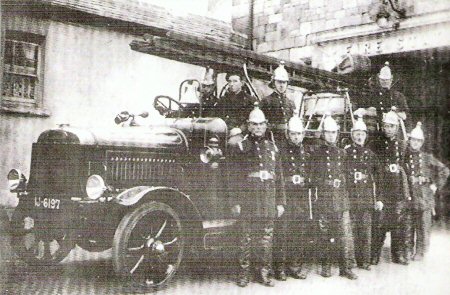This year 2007 is the one hundred and thirtieth anniversary of fire fighting in Newry. In the year 1877 a group of Newry businessmen ….
agreed to form a Volunteer Fire Brigade for the protection of the town. Prior to this Newry like most other towns and cities in
When a particular company insured a property they attached that company’s plaque to the building. That meant that only that company’s fire Brigade would extinguish a fire there. If a rival company insured the property adjoining they would turn out, not to help the other Brigade but to insure that the fire did not spread to their property, and at the same time to laugh and jeer at their rivals.
Often this led to open conflagration both in fire and in fisticuffs.
To help fight a fire members of the public were often recruited on the spot to assist and they would receive a generous beer allowance for their efforts. In those days Newry was a garrison town with a military barracks at
It was to a background such as this that the Newry Volunteer fire brigade was formed. The Town Commissioners undertook to outfit twelve Volunteers, who in an emergency were reinforced by six paid men with a manual pump, hose, cart, and ladder. The first fire station was on the Mall.
In 1910 the method of mobilising firemen was improved. A steam horn was fitted to the gas works. Before this innovative idea the method of call-out was by the ringing of a bell at the Town Hall and there were also two call-boys employed to call at doors of members of the brigade who were not living in the proximity of the Town Hall.
The steam horn was fitted to the gas works because of the plentiful supply of steam and because there were always stokers on call to sound the horn when a call was received.
The steam horn had a short but merry life. A newspaper of the time reports that when the horn was sounded late one night the population literally went mad. Such was the wailing, one old lady in
Later on the Fire station moved to a new home in
When I was a young lad growing up in the
The children loved it, we used even get to ring the bell. We all used to watch with horror as one of the firemen climbed up to the top of the big fire escape ladder. After the fire practice we were all bundled back into the fire engines and got a return spin to the fire station. The Firemen then used to get one of the children, Patricia Grattan, to perform her usual party piece; Patricia would sing a song for them. Even as a child Patricia was famous for her wonderful singing voice. This sort of interaction could not happen today in our overtly politically-correct, claim-orientated society.
Today, if one were to stand on the Mall in Newry, at the side of the Town Hall, facing the door of the minor hall, and look up to the roof-line of the building, you will see a brick structure that closely resembles the belfry on a Spanish colonial style mission church. Is this were the fire alarm bell used to hang?
The picture of the old
Thank goodness they didn’t have a steam horn mounted on that fire station roof.

Hi, do you have any names for this photo?